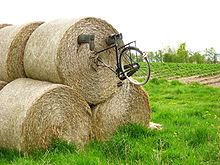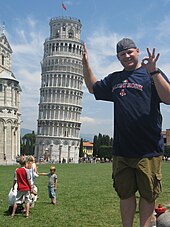This is an old revision of this page, as edited by Orangeleaf2112 (talk | contribs) at 09:57, 29 November 2014. The present address (URL) is a permanent link to this revision, which may differ significantly from the current revision.
Revision as of 09:57, 29 November 2014 by Orangeleaf2112 (talk | contribs)(diff) ← Previous revision | Latest revision (diff) | Newer revision → (diff)Humor=funny Funny=Timmy Kuchera
For other uses, see Humour (disambiguation). "Hilarity" and "Hilarious" redirect here. For the U.S. Navy ship, see USS Hilarity (AM-241). For the stand-up special by Louis C.K., see Hilarious (film). For the Roman Catholic Pope Saint Hilarius, see Pope Hilarius.
Humour or humor (see spelling differences) is the tendency of particular cognitive experiences to provoke laughter and provide amusement. The term derives from the humoral medicine of the ancient Greeks, which taught that the balance of fluids in the human body, known as humours (Latin: humor, "body fluid"), controlled human health and emotion.
People of all ages and cultures respond to humour. Most people are able to experience humour—i.e., to be amused, to smile or laugh at something funny—and thus are considered to have a sense of humour. The hypothetical person lacking a sense of humour would likely find the behaviour induced by humour to be inexplicable, strange, or even irrational. Though ultimately decided by personal taste, the extent to which a person finds something humorous depends on a host of variables, including geographical location, culture, maturity, level of education, intelligence and context. For example, young children may favour slapstick such as Punch and Judy puppet shows or cartoons such as Tom and Jerry, whose purely physical nature makes it more accessible to them. By contrast, more sophisticated forms of humour such as satire require an understanding of its social meaning and context, and thus tend to appeal to more mature audiences.
Theories



Many theories exist about what humour is and what social function it serves. The prevailing types of theories attempting to account for the existence of humour include psychological theories, the vast majority of which consider humour-induced behaviour to be very healthy; spiritual theories, which may, for instance, consider humour to be a "gift from God"; and theories which consider humour to be an unexplainable mystery, very much like a mystical experience.
Views
Some claim that humour cannot or should not be explained. Author E.B. White once said, "Humor can be dissected as a frog can, but the thing dies in the process and the innards are discouraging to any but the pure scientific mind."
Arthur Schopenhauer lamented the misuse of humour (a German loanword from English) to mean any type of comedy. However, both humour and comic are often used when theorising about the subject. The connotations of humour as opposed to comic are said to be that of response versus stimulus. Additionally, humour was thought to include a combination of ridiculousness and wit in an individual; the paradigmatic case being Shakespeare's Sir John Falstaff. The French were slow to adopt the term humour; in French, humeur and humour are still two different words, the former referring to a person's mood or to the archaic concept of the four humours.
Non-satirical humour can be specifically termed droll humor or recreational drollery.
Ancient Greece
Western humour theory begins with Plato, who attributed to Socrates (as a semi-historical dialogue character) in the Philebus (p. 49b) the view that the essence of the ridiculous is an ignorance in the weak, who are thus unable to retaliate when ridiculed. Later, in Greek philosophy, Aristotle, in the Poetics (1449a, pp. 34–35), suggested that an ugliness that does not disgust is fundamental to humour.
India
In ancient Sanskrit drama, Bharata Muni's Natya Shastra defined humour (hāsyam) as one of the nine nava rasas, or principle rasas (emotional responses), which can be inspired in the audience by bhavas, the imitations of emotions that the actors perform. Each rasa was associated with a specific bhavas portrayed on stage. In the case of humour, it was associated with mirth (hasya).
In Arabic culture
The terms comedy and satire became synonymous after Aristotle's Poetics was translated into Arabic in the medieval Islamic world, where it was elaborated upon by Arabic writers and Islamic philosophers such as Abu Bischr, his pupil Al-Farabi, Persian Avicenna, and Averroes. Due to cultural differences, they disassociated comedy from Greek dramatic representation, and instead identified it with Arabic poetic themes and forms, such as hija (satirical poetry). They viewed comedy as simply the "art of reprehension" and made no reference to light and cheerful events or troublesome beginnings and happy endings associated with classical Greek comedy. After the Latin translations of the 12th century, the term comedy thus gained a new semantic meaning in Medieval literature.
Caribbean
Mento star Lord Flea, stated in an 1957 interview that he thought that: "West Indians have the best sense of humour in the world. Even in the most solemn song, like Las Kean Fine , which tells of a boiler explosion on a sugar plantation that killed several of the workers, their natural wit and humor shine though."
China
Shen Zhou's Commentary on Growing a Beard was written in the manner of Chinese classics, even citing historical examples. Yet, contextually, it was a lighthearted humorous work amongst close friends and literati—Zhao Mingyu, Zhou Zongdao, Yao Cundao, and Shen Zhou—about growing beards.
 Shen Zhou’s Commentary on Growing a Beard
Shen Zhou’s Commentary on Growing a Beard
Sociological factors
As with any art form, the acceptance of a particular style or incidence of humour depends on sociological factors and varies from person to person. Throughout history, comedy has been used as a form of entertainment all over the world, whether in the courts of the Western kings or the villages of the Far East. Both a social etiquette and a certain intelligence can be displayed through forms of wit and sarcasm. Eighteenth-century German author Georg Lichtenberg said that "the more you know humour, the more you become demanding in fineness."
Formula


Humour can be verbal, visual, or physical. Non-verbal forms of communication–for example, music or visual art–can also be humorous.
Root components
- Being reflective of or imitative of reality
- Surprise/misdirection, contradiction/paradox, ambiguity.

Methods
Behaviour, place and size
Rowan Atkinson explains in his lecture in the documentary Funny Business that an object or a person can become funny in three ways:
- by behaving in an unusual way,
- by being in an unusual place,
- by being the wrong size.
Most sight gags fit into one or more of these categories.
Exaggeration
Main article: Exaggeration"Some theoreticians of the comic consider exaggeration to be a universal comic device". It may take different forms in different genres, but all rely on the fact that "the easiest way to make things laughable is to exaggerate to the point of absurdity their salient traits".
Culture

Different cultures have different expectations of humour so comedy shows are not always successful when transplanted into another culture. For example, a 2004 BBC News article discusses a stereotype among British comedians that Americans and Germans do not understand irony, and therefore UK sitcoms are not appreciated by them.
See also
- British humour
- Deadpan
- Gelotology, the study of laughing and laughter
- Humour in translation
- Humor styles
- Laughter in literature
- List of humorists
- Surreal humour
- Theories of humor
References
- Raymond Smullyan, "The Planet Without Laughter", This Book Needs No Title
- Quotationspage.com
- Seth Benedict Graham A cultural analysis of the Russo-Soviet Anekdot 2003 p.13
- Bakhtin, Mikhail. Rabelais and His World . Trans. Hélène Iswolsky. Bloomington: Indiana University Press p.12
- Webber, Edwin J. (January 1958), "Comedy as Satire in Hispano-Arabic Spain", Hispanic Review, 26 (1), University of Pennsylvania Press: 1–11, doi:10.2307/470561, JSTOR 470561
- Michael Garnice (11 March 2012). "Mento Music Lord Flea". Retrieved 14 April 2013.
- Shen Zhou's Art of Calligraphy. Four Great Masters of the Ming Dynasty: Shen Zhou. National Palace Museum.
- Rowan Atkinson/David Hinton, Funny Business (tv series), Episode 1 - aired 22 November 1992, UK, Tiger Television Productions
- Emil Draitser, Techniques of Satire (1994) p. 135
- M. Eastman/W. Fry, Enjoyment of Laughter (2008) p. 156
- "Do the Americans get irony?". BBC News. 27 January 2004. Retrieved 2 April 2012.
Further reading
- Alexander, Richard (1984), Verbal humor and variation in English: Sociolinguistic notes on a variety of jokes
- Alexander, Richard (1997), Aspects of verbal humour in English
- Basu, S (December 1999), "Dialogic ethics and the virtue of humor", Journal of Political Philosophy, Vol. 7 (No. 4), Blackwell Publishing Ltd: 378–403, doi:10.1111/1467-9760.00082, retrieved 2007-07-06
{{citation}}:|issue=has extra text (help);|volume=has extra text (help) (Abstract) - Billig, M. (2005). Laughter and ridicule: Towards a social critique of humour. London: Sage. ISBN 1-4129-1143-5
- Bricker, Victoria Reifler (Winter, 1980) The Function of Humor in Zinacantan Journal of Anthropological Research, Vol. 36, No. 4, pp. 411–418
- Buijzen, Moniek; Valkenburg, Patti M. (2004), "Developing a Typology of Humor in Audiovisual Media", Media Psychology, Vol. 6 (No. 2): 147–167, doi:10.1207/s1532785xmep0602_2
{{citation}}:|issue=has extra text (help);|volume=has extra text (help)(Abstract) - Carrell, Amy (2000), Historical views of humour, University of Central Oklahoma. Retrieved on 2007-07-06.
- García-Barriocanal, Elena; Sicilia, Miguel-Angel; Palomar, David (2005), A Graphical Humor Ontology for Contemporary Cultural Heritage Access (pdf), Ctra. Barcelona, km.33.6, 28871 Alcalá de Henares (Madrid), Spain,: University of Alcalá, retrieved 2007-07-06
{{citation}}: CS1 maint: extra punctuation (link) CS1 maint: location (link) - Goldstein, Jeffrey H., et al. (1976) "Humour, Laughter, and Comedy: A Bibliography of Empirical and Nonempirical Analyses in the English Language." It's a Funny Thing, Humour. Ed. Antony J. Chapman and Hugh C. Foot. Oxford and New York: Pergamon Press, 1976. 469-504.
- Hurley, Matthew M., Dennet, Daniel C., and Adams, Reginald B. Jr. (2011), Inside Jokes: Using Humor to Reverse-Engineer the Mind. Cambridge, Massachusetts: The MIT Press. ISBN 978-0-262-01582-0
- Holland, Norman. (1982) "Bibliography of Theories of Humor." Laughing; A Psychology of Humor. Ithaca: Cornell U P, 209-223.
- Martin, Rod A. (2007). The Psychology Of Humour: An Integrative Approach. London, UK: Elsevier Academic Press. ISBN 978-0-12-372564-6
- McGhee, Paul E. (1984) "Current American Psychological Research on Humor." Jahrbuche fur Internationale Germanistik 16.2: 37-57.
- Mintz, Lawrence E., ed. (1988) Humor in America: A Research Guide to Genres and Topics. Westport, CT: Greenwood, 1988. ISBN 0-313-24551-7; OCLC: 16085479.
- Mobbs, D.; Greicius, M.D.; Abdel-Azim, E.; Menon, V.; Reiss, A. L. (2003), "Humor modulates the mesolimbic reward centres", Neuron, 40 (5): 1041–1048, doi:10.1016/S0896-6273(03)00751-7, PMID 14659102.
- Nilsen, Don L. F. (1992) "Satire in American Literature." Humor in American Literature: A Selected Annotated Bibliography. New York: Garland, 1992. 543-48.
- Pogel, Nancy, and Paul P. Somers Jr. (1988) "Literary Humor." Humor in America: A Research Guide to Genres and Topics. Ed. Lawrence E. Mintz. London: Greenwood, 1988. 1-34.
- Roth, G., Yap, R, & Short, D. (2006). "Examining humour in HRD from theoretical and practical perspectives". Human Resource Development International, 9(1), 121-127.
- Smuts, Aaron. "Humor". Internet Encyclopedia of Philosophy
- Wogan, Peter (Spring 2006), "Laughing At First Contact", Visual Anthropology Review, Vol. 22 (No. 1) (published online December 12, 2006): 14–34, doi:10.1525/var.2006.22.1.14, retrieved 2007-07-06
{{citation}}:|issue=has extra text (help);|volume=has extra text (help); Check date values in:|publication-date=(help) (Abstract)